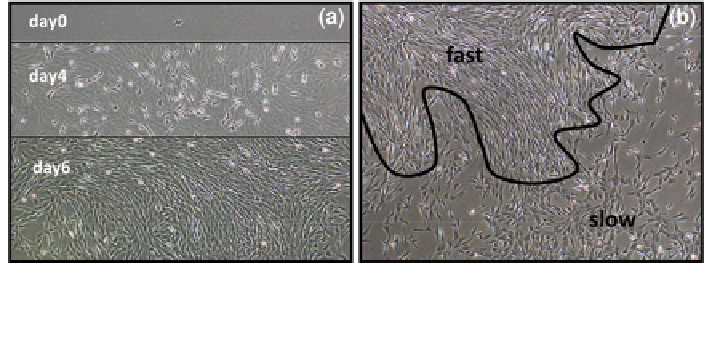Biomedical Engineering Reference
In-Depth Information
Fig. 1 Expansion of MSCs in vitro. a Massive expansion of an ovine MSC clone within 6 days of
in vitro culture at standard culture conditions [
101
]. b Spatial competition of ovine MSC clones
in vitro. A fast growing clone spreads into the area already occupied by a slow growing clone
potential or differentiation status as well as their expression of adhesion molecules
or cell surface antigens [
54
]. Accordingly, a functional definition of tissue stem
cells has been given by Loeffler and Roeder [
53
] that includes heterogeneity as a
characteristic feature: 'Tissue stem cells are a potentially heterogeneous popula-
tion of undifferentiated cells that are capable of proliferation and production of a
large number of differentiated tissue cells for replenishing tissue continuously and
after injury, while self-maintaining their population.'
However, isolation of stem cells for subsequent applications by applying these
functional criteria is impossible, simply because a cell cannot be differentiated in
different lineages while simultaneously maintaining its 'stem cell' state. As an
alternative method marker systems have been studied in order to identify
individual cells that carry stem cell properties. But, while well defined marker
systems are available for other stem cells, e.g. for haematopoietic stem cells
(HSCs, [
27
]), for MSCs such marker systems are still a matter of debate [
42
]. First
effective protocols have been suggested more than ten years ago [
67
]. Currently,
standard isolation protocols for human MSCs use combinations of up to ten surface
markers. There is common agreement that more than 95% of the cells must express
CD73, CD90 and CD105 and less than 2% CD35, CD45 together with CD11b or
CD14 [
24
,
25
,
48
]. However, the MSCs isolated applying related protocols show
still a large variance in the expression of these markers. Subpopulations of them
with more defined expression have been demonstrated to carry different functional
potential (e.g. Sca-1, [
13
]). Moreover, gene expression analysis of individual MSCs
[
82
,
83
] demonstrated MSC heterogeneity even on the single cell level. Despite a
common molecular signature of potential multilineage differentiation capacity the
analysed cells show considerable variance in expression.
During expansion MSCs adapt to the in vitro conditions and change their
expression profile until they reach a senescent state as described in detail by
Wagner et al. [
94
]. How this adaptation process affects MSC heterogeneity will be
discussed below. The related changes in the expression profile are accompanied
by morphological changes of the cells. Initially many of the cells are round and

Search WWH ::

Custom Search